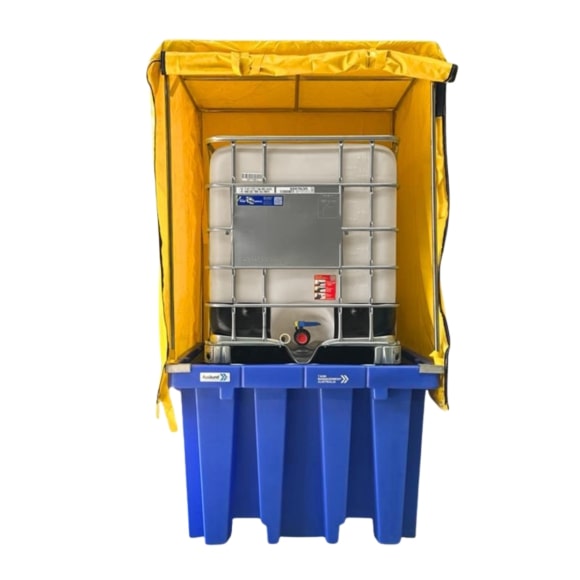
IBC Bunds: Covered vs Open, Single vs Pallet Bunds — Which Is Right for Your Site?
IBC bunds are essential for any site handling bulk liquids, especially hazardous ones. They’re not just a safety precaution—they’re a compliance requirement. Whether you're managing one IBC indoors or a pallet of chemicals out in the elements, knowing the right type of bund to use can prevent environmental damage and help your operation stay regulation-ready. This guide covers the key differences between covered and open IBC bunds, single vs pallet bunds, and how to choose what’s best for your setup.
What Is an IBC Bund (and Why Is It Essential)?
An IBC bund is a secondary containment system placed beneath an Intermediate Bulk Container (IBC), primarily used to catch leaks or spills before they spread. These systems are vital for sites storing chemicals, oils, or other hazardous substances in bulk.
Each bund is built to hold at least 110% of an IBC’s volume, typically 1,000 litres, ensuring sufficient containment if a tank fails. Made from materials like polyethylene or galvanised steel, they resist chemical corrosion while remaining strong enough for industrial use.
Bunds are often used in tandem with Tanks & IBC Containers across sectors like mining, agriculture, and manufacturing—anywhere that safe, reliable liquid storage is needed.
Covered vs Open IBC Bunds: Key Differences
The main difference between covered and open IBC bunds comes down to weather protection.
Covered IBC bunds: These include a polyethylene cover, often reinforced with a steel frame. These are designed to shield the IBC and bund from sun and rain, protecting the contents and preventing rainwater from filling the bund. They're the go-to for outdoor IBC storage, where UV damage or dilution from rainfall is a concern.
Open bunds: These are better suited to indoor or roofed environments, where exposure to the elements isn't an issue. They’re lighter, easier to move, and offer quick access for frequent inspections or changes.
If your site is outdoors or subject to changing weather, a covered IBC bund helps maintain containment capacity and safeguards stored liquids from contamination or degradation.
Single IBC Bunds vs Pallet Bunds
Choosing between a single bund and a pallet bund depends on your site layout and how many IBCs you're working with.
Single IBC bunds: These are compact units built to hold one container. They're ideal for smaller operations or when containers are spread across various locations. Many come with removable grates for cleaning and forklift pockets for relocation.
Pallet bunds: These accommodate two or more IBCs on a single base. These pallet bund systems improve space efficiency and help standardise containment across busy worksites. They're commonly found in industrial plants, chemical storage facilities, and high-volume processing areas.
For either setup, choosing the right spill containment bund can reduce clean-up time, increase site safety, and help meet environmental requirements.
Choosing the Right IBC Bund for Your Site
Several factors can influence which bund setup best suits your needs:
Number of containers: Use a single bund for isolated containers, and a pallet bund if storing multiple IBCs in one location.
Indoor or outdoor use: Choose a covered bund for exposed environments to protect against rain and UV, or an open bund for indoor convenience.
Type of liquid stored: Consider chemical compatibility—polyethylene is suitable for corrosive substances, while steel works better for flammable materials.
Handling needs: Look for features like forklift pockets or removable grates to simplify movement and cleaning.
Accessories and support: Sites may benefit from dedicated Tank Accessories such as valve kits, labels, or bund covers to enhance functionality.
The right choice comes down to practical use and compliance with safety standards.
Compliance & Safety Considerations
In Australia, secondary containment like ibc spill bunds is a legal requirement for storing hazardous liquids. Regulations often demand bunds be able to hold 110% of the largest container's volume—or 25% of the total volume stored—whichever is greater.
Bunded pallets must also meet requirements related to height, structural strength, chemical resistance, and ease of maintenance. Sites must inspect bunds regularly for leaks or degradation and keep records to show compliance.
Spill protection isn’t just about hardware. Best practice includes:
Segregating incompatible chemicals
Keeping bunds clean and free from excess rainwater
Ensuring safe access for emergency response
Using tested and certified equipment, such as IBC Spill Containment Bunds
Good bunding supports workplace safety, environmental protection, and operational reliability.
Shop IBC Bunds at Tank Management
Whether you need single-unit containment or a full-scale bunding solution for outdoor storage, Tank Management provides certified, durable systems that meet spill containment standards. Explore their ibc bunds range today to equip your site for safety and compliance.
FAQs
1. What is an IBC bund used for?
An IBC bund captures any leaks or spills from bulk liquid containers. It's a passive containment solution designed to prevent environmental pollution and support workplace safety compliance.
2. What’s the difference between covered and open IBC bunds?
Covered bunds shield the IBC and stored liquid from weather, making them suitable for outdoor use. Open bunds don’t offer weather protection but are easier to handle and maintain—ideal for indoor settings.
3. How many IBCs can fit in a pallet bund?
A single bund holds one IBC, while pallet bunds are built to store two or more containers on one spill containment unit, reducing space use and increasing operational efficiency.
4. Do I legally need an IBC bund?
Yes. Australian regulations require secondary containment systems for hazardous liquids, and bunds are the most common way to achieve this. Failure to comply can result in fines and environmental penalties.
5. Where can I buy IBC bunds in Australia?
You can explore a full range of ibc bunds at Tank Management Australia, including covered, open, single, and pallet options to suit different site needs.







 Previous article
Previous article